ESP FIAT DUCATO 2010 Owner handbook (in English)
[x] Cancel search | Manufacturer: FIAT, Model Year: 2010, Model line: DUCATO, Model: FIAT DUCATO 2010Pages: 286, PDF Size: 12.53 MB
Page 123 of 286
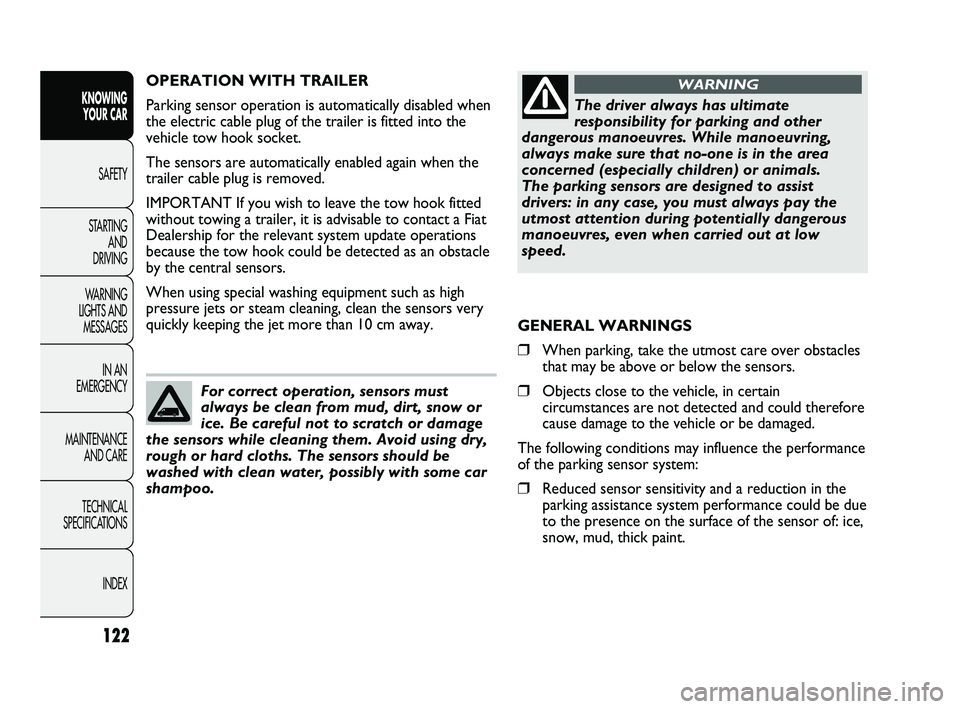
122
KNOWING
YOUR CAR
SAFETY
STARTING
AND
DRIVING
WARNING
LIGHTS AND
MESSAGES
IN AN
EMERGENCY
MAINTENANCE
AND CARE
TECHNICAL
SPECIFICATIONS
INDEX
OPERATION WITH TRAILER
Parking sensor operation is automatically disabled when
the electric cable plug of the trailer is fitted into the
vehicle tow hook socket.
The sensors are automatically enabled again when the
trailer cable plug is removed.
IMPORTANT If you wish to leave the tow hook fitted
without towing a trailer, it is advisable to contact a Fiat
Dealership for the relevant system update operations
because the tow hook could be detected as an obstacle
by the central sensors.
When using special washing equipment such as high
pressure jets or steam cleaning, clean the sensors very
quickly keeping the jet more than 10 cm away.
The driver always has ultimate
responsibility for parking and other
dangerous manoeuvres. While manoeuvring,
always make sure that no-one is in the area
concerned (especially children) or animals.
The parking sensors are designed to assist
drivers: in any case, you must always pay the
utmost attention during potentially dangerous
manoeuvres, even when carried out at low
speed.
WARNING
For correct operation, sensors must
always be clean from mud, dirt, snow or
ice. Be careful not to scratch or damage
the sensors while cleaning them. Avoid using dry,
rough or hard cloths. The sensors should be
washed with clean water, possibly with some car
shampoo.
GENERAL WARNINGS
❒When parking, take the utmost care over obstacles
that may be above or below the sensors.
❒Objects close to the vehicle, in certain
circumstances are not detected and could therefore
cause damage to the vehicle or be damaged.
The following conditions may influence the performance
of the parking sensor system:
❒Reduced sensor sensitivity and a reduction in the
parking assistance system performance could be due
to the presence on the surface of the sensor of: ice,
snow, mud, thick paint.
037-128 DUCATO LUM EN 7ed 6/21/10 2:11 PM Page 122
Page 133 of 286
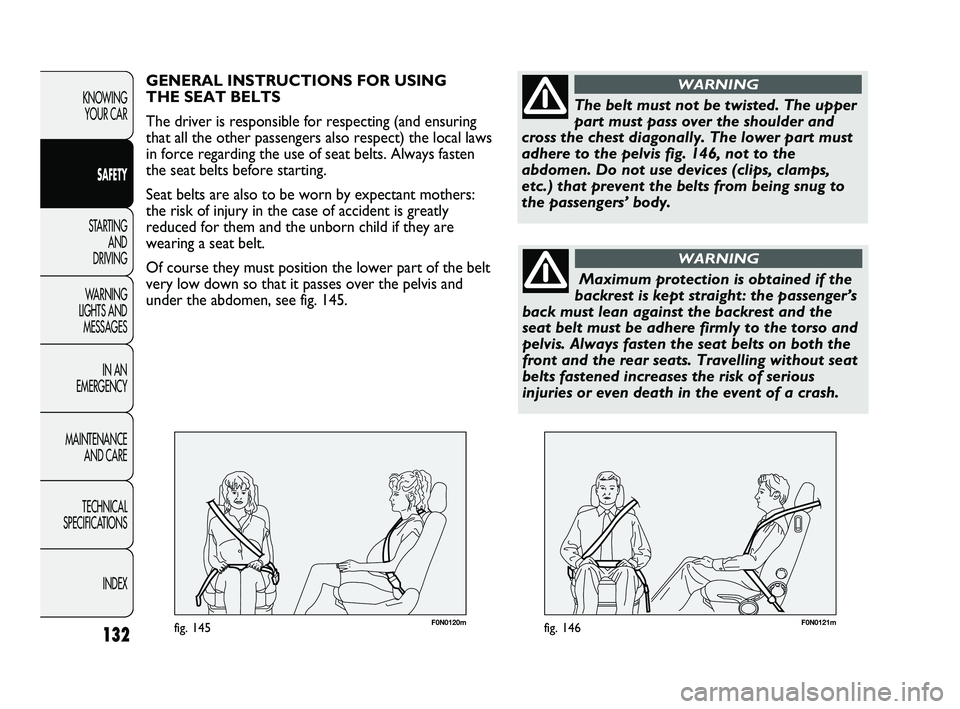
F0N0121mfig. 146132
KNOWING
YOUR CAR
SAFETY
STARTING
AND
DRIVING
WARNING
LIGHTS AND
MESSAGES
IN AN
EMERGENCY
MAINTENANCE
AND CARE
TECHNICAL
SPECIFICATIONS
INDEX
F0N0120mfig. 145
GENERAL INSTRUCTIONS FOR USING
THE SEAT BELTS
The driver is responsible for respecting (and ensuring
that all the other passengers also respect) the local laws
in force regarding the use of seat belts. Always fasten
the seat belts before starting.
Seat belts are also to be worn by expectant mothers:
the risk of injury in the case of accident is greatly
reduced for them and the unborn child if they are
wearing a seat belt.
Of course they must position the lower part of the belt
very low down so that it passes over the pelvis and
under the abdomen, see fig. 145.
The belt must not be twisted. The upper
part must pass over the shoulder and
cross the chest diagonally. The lower part must
adhere to the pelvis fig. 146, not to the
abdomen. Do not use devices (clips, clamps,
etc.) that prevent the belts from being snug to
the passengers’ body.
WARNING
Maximum protection is obtained if the
backrest is kept straight: the passenger’s
back must lean against the backrest and the
seat belt must be adhere firmly to the torso and
pelvis. Always fasten the seat belts on both the
front and the rear seats. Travelling without seat
belts fastened increases the risk of serious
injuries or even death in the event of a crash.
WARNING
129-146 DUCATO LUM EN 7ed 6/21/10 2:12 PM Page 132
Page 142 of 286
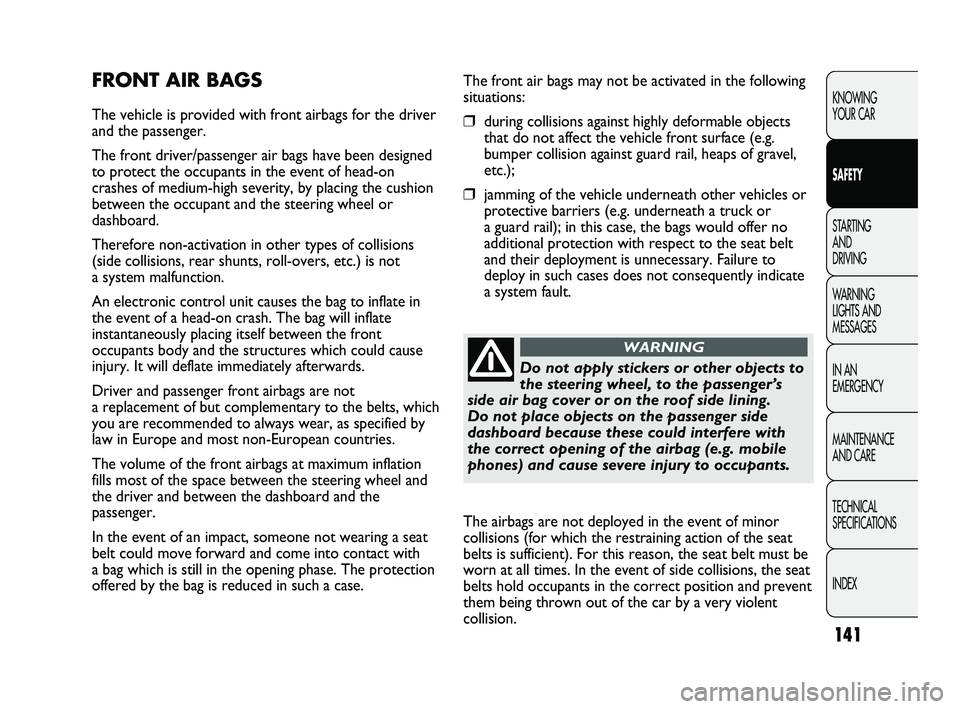
141
KNOWING
YOUR CAR
SAFETY
STARTING
AND
DRIVING
WARNING
LIGHTS AND
MESSAGES
IN AN
EMERGENCY
MAINTENANCE
AND CARE
TECHNICAL
SPECIFICATIONS
INDEX
The front air bags may not be activated in the following
situations:
❒during collisions against highly deformable objects
that do not affect the vehicle front surface (e.g.
bumper collision against guard rail, heaps of gravel,
etc.);
❒jamming of the vehicle underneath other vehicles or
protective barriers (e.g. underneath a truck or
a guard rail); in this case, the bags would offer no
additional protection with respect to the seat belt
and their deployment is unnecessary. Failure to
deploy in such cases does not consequently indicate
a system fault.
FRONT AIR BAGS
The vehicle is provided with front airbags for the driver
and the passenger.
The front driver/passenger air bags have been designed
to protect the occupants in the event of head-on
crashes of medium-high severity, by placing the cushion
between the occupant and the steering wheel or
dashboard.
Therefore non-activation in other types of collisions
(side collisions, rear shunts, roll-overs, etc.) is not
a system malfunction.
An electronic control unit causes the bag to inflate in
the event of a head-on crash. The bag will inflate
instantaneously placing itself between the front
occupants body and the structures which could cause
injury. It will deflate immediately afterwards.
Driver and passenger front airbags are not
a replacement of but complementary to the belts, which
you are recommended to always wear, as specified by
law in Europe and most non-European countries.
The volume of the front airbags at maximum inflation
fills most of the space between the steering wheel and
the driver and between the dashboard and the
passenger.
In the event of an impact, someone not wearing a seat
belt could move forward and come into contact with
a bag which is still in the opening phase. The protection
offered by the bag is reduced in such a case.
Do not apply stickers or other objects to
the steering wheel, to the passenger’s
side air bag cover or on the roof side lining.
Do not place objects on the passenger side
dashboard because these could interfere with
the correct opening of the airbag (e.g. mobile
phones) and cause severe injury to occupants.
WARNING
The airbags are not deployed in the event of minor
collisions (for which the restraining action of the seat
belts is sufficient). For this reason, the seat belt must be
worn at all times. In the event of side collisions, the seat
belts hold occupants in the correct position and prevent
them being thrown out of the car by a very violent
collision.
129-146 DUCATO LUM EN 7ed 6/21/10 2:12 PM Page 141
Page 149 of 286
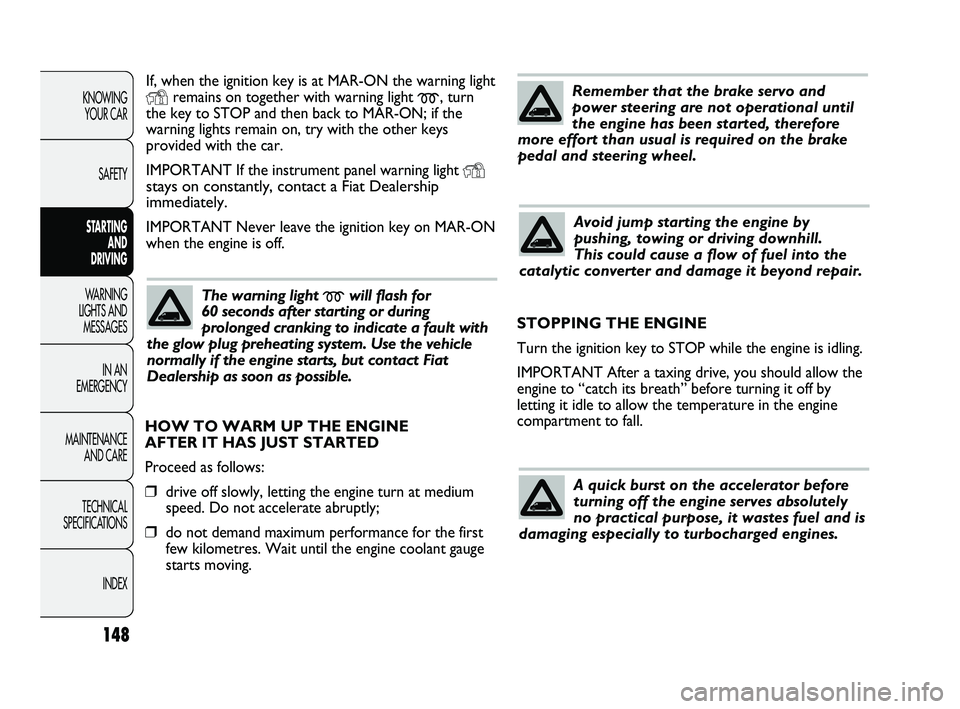
148
KNOWING
YOUR CAR
SAFETY
STARTING
AND
DRIVING
WARNING
LIGHTS AND
MESSAGES
IN AN
EMERGENCY
MAINTENANCE
AND CARE
TECHNICAL
SPECIFICATIONS
INDEX
If, when the ignition key is at MAR-ON the warning light
Yremains on together with warning light m, turn
the key to STOP and then back to MAR-ON; if the
warning lights remain on, try with the other keys
provided with the car.
IMPORTANT If the instrument panel warning light
Ystays on constantly, contact a Fiat Dealership
immediately.
IMPORTANT Never leave the ignition key on MAR-ON
when the engine is off.
The warning light mwill flash for
60 seconds after starting or during
prolonged cranking to indicate a fault with
the glow plug preheating system. Use the vehicle
normally if the engine starts, but contact Fiat
Dealership as soon as possible.
Remember that the brake servo and
power steering are not operational until
the engine has been started, therefore
more effort than usual is required on the brake
pedal and steering wheel.
Avoid jump starting the engine by
pushing, towing or driving downhill.
This could cause a flow of fuel into the
catalytic converter and damage it beyond repair.
HOW TO WARM UP THE ENGINE
AFTER IT HAS JUST STARTED
Proceed as follows:
❒drive off slowly, letting the engine turn at medium
speed. Do not accelerate abruptly;
❒do not demand maximum performance for the first
few kilometres. Wait until the engine coolant gauge
starts moving.STOPPING THE ENGINE
Turn the ignition key to STOP while the engine is idling.
IMPORTANT After a taxing drive, you should allow the
engine to “catch its breath” before turning it off by
letting it idle to allow the temperature in the engine
compartment to fall.
A quick burst on the accelerator before
turning off the engine serves absolutely
no practical purpose, it wastes fuel and is
damaging especially to turbocharged engines.
147-160 DUCATO LUM EN 7ed 6/21/10 2:13 PM Page 148
Page 153 of 286
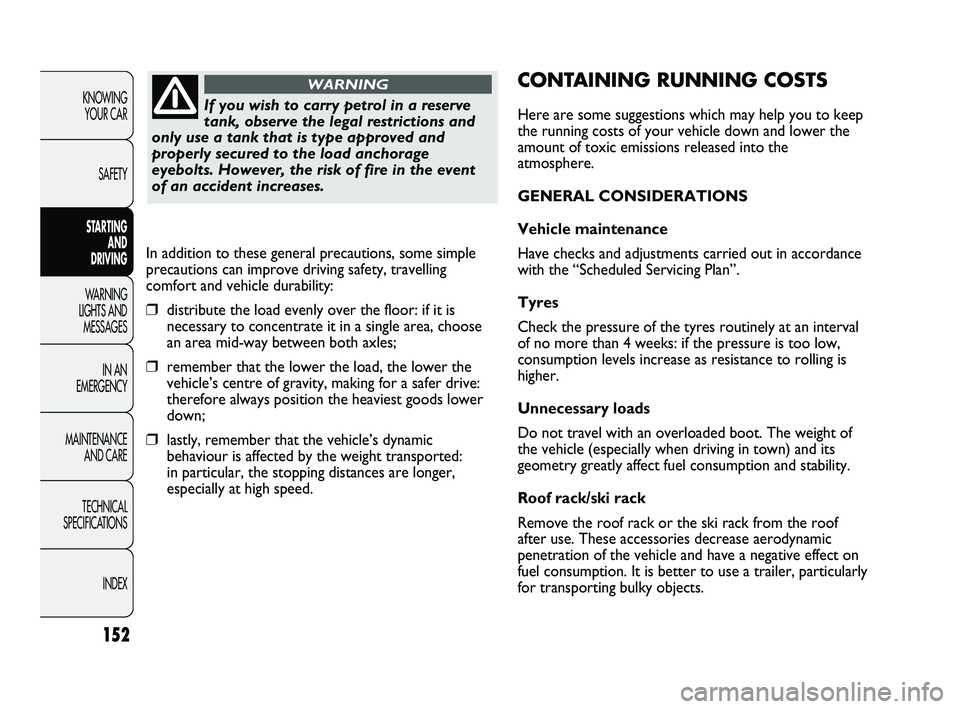
152
KNOWING
YOUR CAR
SAFETY
STARTING
AND
DRIVING
WARNING
LIGHTS AND
MESSAGES
IN AN
EMERGENCY
MAINTENANCE
AND CARE
TECHNICAL
SPECIFICATIONS
INDEX
CONTAINING RUNNING COSTS
Here are some suggestions which may help you to keep
the running costs of your vehicle down and lower the
amount of toxic emissions released into the
atmosphere.
GENERAL CONSIDERATIONS
Vehicle maintenance
Have checks and adjustments carried out in accordance
with the “Scheduled Servicing Plan”.
Tyres
Check the pressure of the tyres routinely at an interval
of no more than 4 weeks: if the pressure is too low,
consumption levels increase as resistance to rolling is
higher.
Unnecessary loads
Do not travel with an overloaded boot. The weight of
the vehicle (especially when driving in town) and its
geometry greatly affect fuel consumption and stability.
Roof rack/ski rack
Remove the roof rack or the ski rack from the roof
after use. These accessories decrease aerodynamic
penetration of the vehicle and have a negative effect on
fuel consumption. It is better to use a trailer, particularly
for transporting bulky objects. In addition to these general precautions, some simple
precautions can improve driving safety, travelling
comfort and vehicle durability:
❒distribute the load evenly over the floor: if it is
necessary to concentrate it in a single area, choose
an area mid-way between both axles;
❒remember that the lower the load, the lower the
vehicle’s centre of gravity, making for a safer drive:
therefore always position the heaviest goods lower
down;
❒lastly, remember that the vehicle’s dynamic
behaviour is affected by the weight transported:
in particular, the stopping distances are longer,
especially at high speed.
If you wish to carry petrol in a reserve
tank, observe the legal restrictions and
only use a tank that is type approved and
properly secured to the load anchorage
eyebolts. However, the risk of fire in the event
of an accident increases.
WARNING
147-160 DUCATO LUM EN 7ed 6/21/10 2:13 PM Page 152
Page 170 of 286
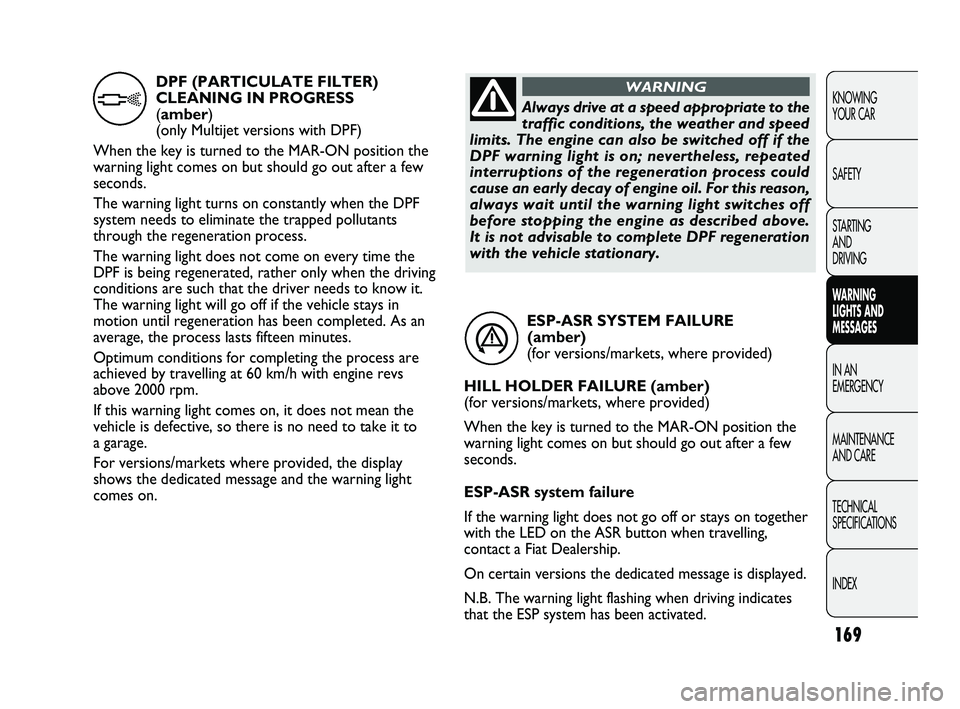
169
KNOWING
YOUR CAR
SAFETY
STARTING
AND
DRIVING
WARNING
LIGHTS AND
MESSAGES
IN AN
EMERGENCY
MAINTENANCE
AND CARE
TECHNICAL
SPECIFICATIONS
INDEX
ESP-ASR SYSTEM FAILURE
(amber)
(for versions/markets, where provided)
HILL HOLDER FAILURE (amber)
(for versions/markets, where provided)
When the key is turned to the MAR-ON position the
warning light comes on but should go out after a few
seconds.
ESP-ASR system failure
If the warning light does not go off or stays on together
with the LED on the ASR button when travelling,
contact a Fiat Dealership.
On certain versions the dedicated message is displayed.
N.B. The warning light flashing when driving indicates
that the ESP system has been activated.
á
DPF (PARTICULATE FILTER)
CLEANING IN PROGRESS
(amber)
(only Multijet versions with DPF)
When the key is turned to the MAR-ON position the
warning light comes on but should go out after a few
seconds.
The warning light turns on constantly when the DPF
system needs to eliminate the trapped pollutants
through the regeneration process.
The warning light does not come on every time the
DPF is being regenerated, rather only when the driving
conditions are such that the driver needs to know it.
The warning light will go off if the vehicle stays in
motion until regeneration has been completed. As an
average, the process lasts fifteen minutes.
Optimum conditions for completing the process are
achieved by travelling at 60 km/h with engine revs
above 2000 rpm.
If this warning light comes on, it does not mean the
vehicle is defective, so there is no need to take it to
a garage.
For versions/markets where provided, the display
shows the dedicated message and the warning light
comes on.
hAlways drive at a speed appropriate to the
traffic conditions, the weather and speed
limits. The engine can also be switched off if the
DPF warning light is on; nevertheless, repeated
interruptions of the regeneration process could
cause an early decay of engine oil. For this reason,
always wait until the warning light switches off
before stopping the engine as described above.
It is not advisable to complete DPF regeneration
with the vehicle stationary.
WARNING
161-172 DUCATO LUM EN 7ed 6/21/10 2:14 PM Page 169
Page 186 of 286
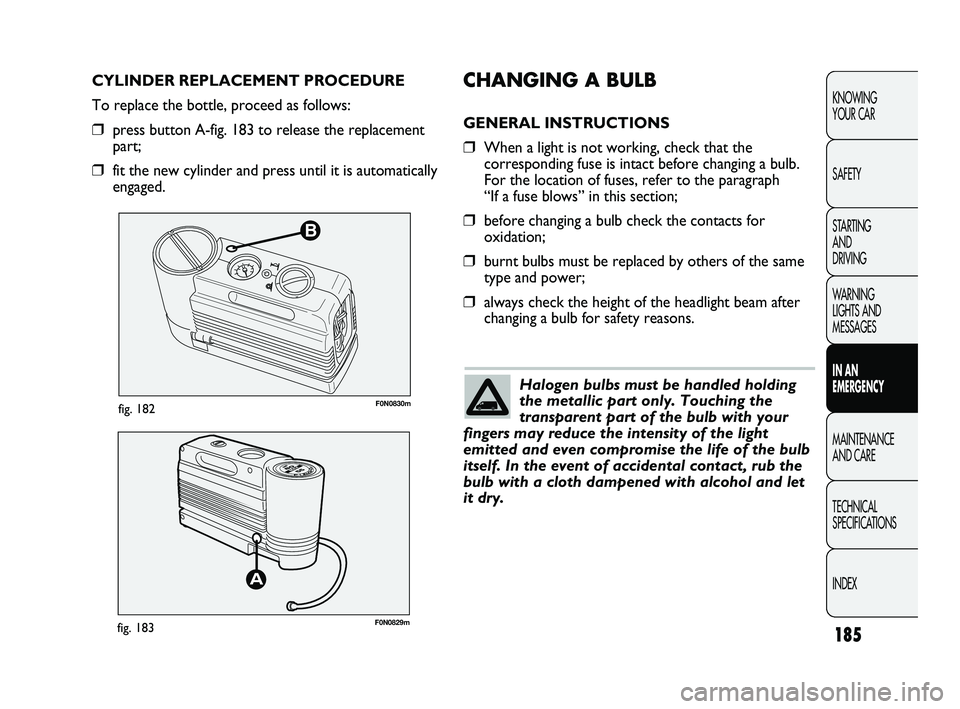
185
KNOWING
YOUR CAR
SAFETY
STARTING
AND
DRIVING
WARNING
LIGHTS AND
MESSAGES
IN AN
EMERGENCY
MAINTENANCE
AND CARE
TECHNICAL
SPECIFICATIONS
INDEX
B
F0N0830mfig. 182
F0N0829mfig. 183
CHANGING A BULB
GENERAL INSTRUCTIONS
❒When a light is not working, check that the
corresponding fuse is intact before changing a bulb.
For the location of fuses, refer to the paragraph
“If a fuse blows” in this section;
❒before changing a bulb check the contacts for
oxidation;
❒burnt bulbs must be replaced by others of the same
type and power;
❒always check the height of the headlight beam after
changing a bulb for safety reasons. CYLINDER REPLACEMENT PROCEDURE
To replace the bottle, proceed as follows:
❒press button A-fig. 183 to release the replacement
part;
❒fit the new cylinder and press until it is automatically
engaged.
Halogen bulbs must be handled holding
the metallic part only. Touching the
transparent part of the bulb with your
fingers may reduce the intensity of the light
emitted and even compromise the life of the bulb
itself. In the event of accidental contact, rub the
bulb with a cloth dampened with alcohol and let
it dry.
173-206 DUCATO LUM EN 8ed 27-10-2010 15:45 Pagina 185
Page 199 of 286
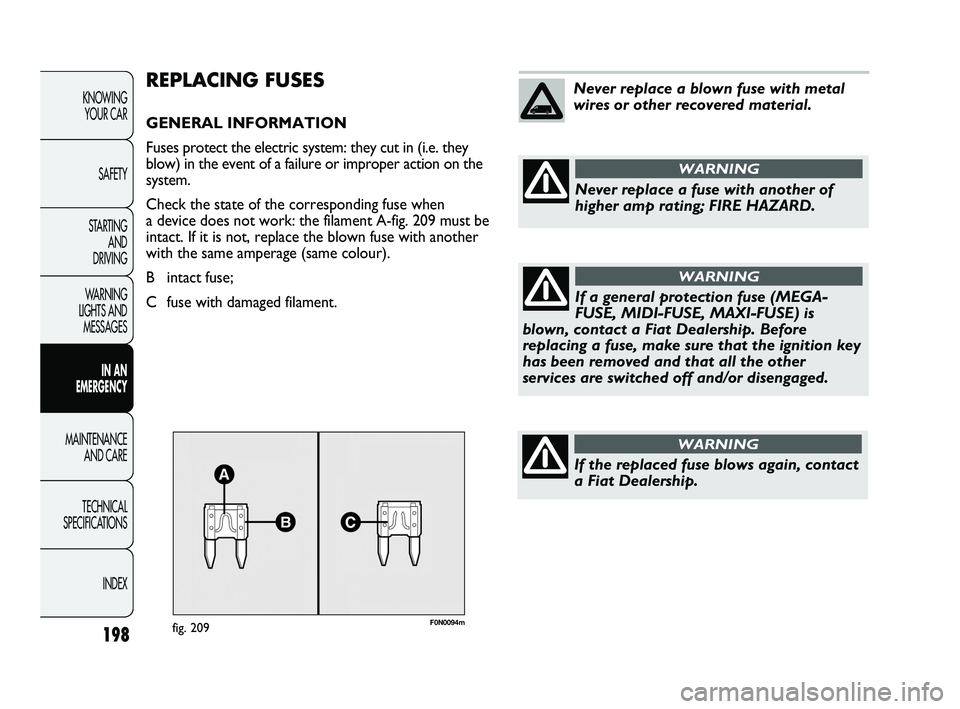
F0N0094mfig. 209
REPLACING FUSES
GENERAL INFORMATION
Fuses protect the electric system: they cut in (i.e. they
blow) in the event of a failure or improper action on the
system.
Check the state of the corresponding fuse when
a device does not work: the filament A-fig. 209 must be
intact. If it is not, replace the blown fuse with another
with the same amperage (same colour).
B intact fuse;
C fuse with damaged filament.
198
KNOWING
YOUR CAR
SAFETY
STARTING
AND
DRIVING
WARNING
LIGHTS AND
MESSAGES
IN AN
EMERGENCY
MAINTENANCE
AND CARE
TECHNICAL
SPECIFICATIONS
INDEX
Never replace a blown fuse with metal
wires or other recovered material.
Never replace a fuse with another of
higher amp rating; FIRE HAZARD.
WARNING
If a general protection fuse (MEGA-
FUSE, MIDI-FUSE, MAXI-FUSE) is
blown, contact a Fiat Dealership. Before
replacing a fuse, make sure that the ignition key
has been removed and that all the other
services are switched off and/or disengaged.
WARNING
If the replaced fuse blows again, contact
a Fiat Dealership.
WARNING
173-206 DUCATO LUM EN 8ed 27-10-2010 15:45 Pagina 198
Page 202 of 286
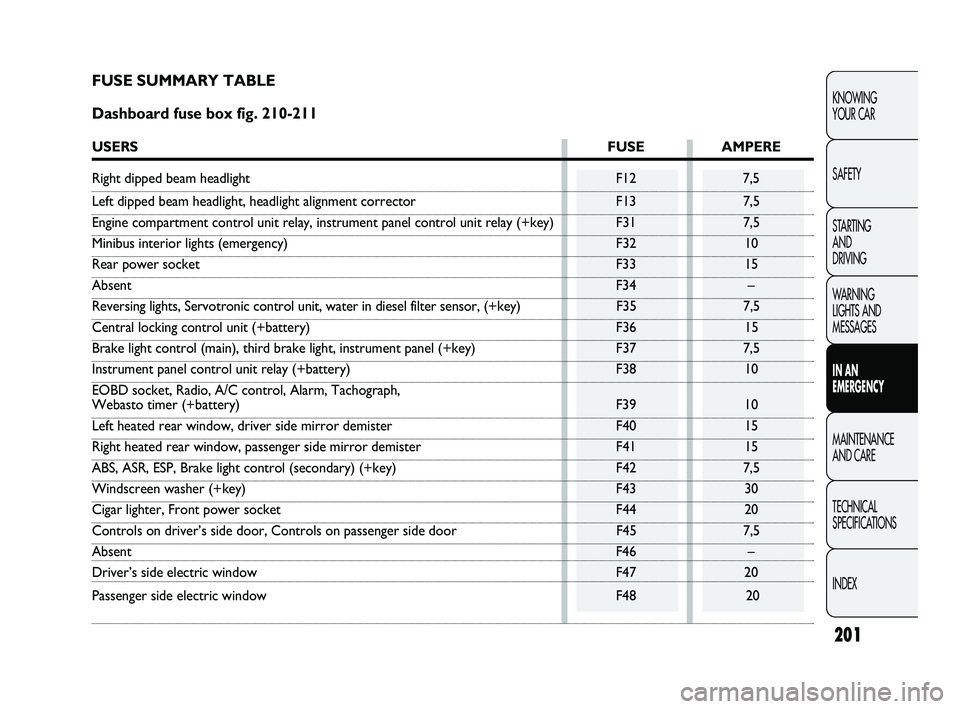
201
KNOWING
YOUR CAR
SAFETY
STARTING
AND
DRIVING
WARNING
LIGHTS AND
MESSAGES
IN AN
EMERGENCY
MAINTENANCE
AND CARE
TECHNICAL
SPECIFICATIONS
INDEX
FUSE SUMMARY TABLE
Dashboard fuse box fig. 210-211
USERSFUSE AMPERE
Right dipped beam headlight F12 7,5
Left dipped beam headlight, headlight alignment corrector F13 7,5
Engine compartment control unit relay, instrument panel control unit relay (+key) F31 7,5
Minibus interior lights (emergency) F32 10
Rear power socket F33 15
AbsentF34 –
Reversing lights, Servotronic control unit, water in diesel filter sensor, (+key) F35 7,5
Central locking control unit (+battery) F36 15
Brake light control (main), third brake light, instrument panel (+key) F37 7,5
Instrument panel control unit relay (+battery) F38 10
EOBD socket, Radio, A/C control, Alarm, Tachograph,
Webasto timer (+battery) F39 10
Left heated rear window, driver side mirror demister F40 15
Right heated rear window, passenger side mirror demister F41 15
ABS, ASR, ESP, Brake light control (secondary) (+key) F42 7,5
Windscreen washer (+key) F43 30
Cigar lighter, Front power socket F44 20
Controls on driver’s side door, Controls on passenger side door F45 7,5
AbsentF46 –
Driver’s side electric window F47 20
Passenger side electric window F48 20
173-206 DUCATO LUM EN 8ed 27-10-2010 15:45 Pagina 201
Page 210 of 286
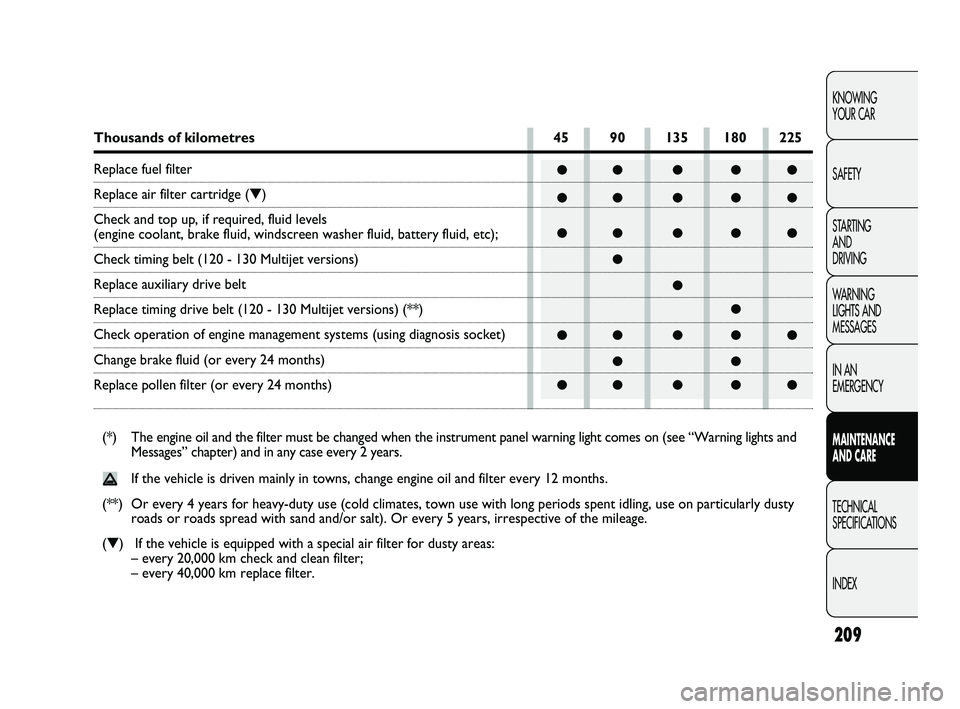
●● ● ● ●
●● ● ● ●
●● ● ● ●
●
●
●
●● ● ● ●
●●
●● ● ● ●
209
KNOWING
YOUR CAR
SAFETY
STARTING
AND
DRIVING
WARNING
LIGHTS AND
MESSAGES
IN AN
EMERGENCY
MAINTENANCE
AND CARE
TECHNICAL
SPECIFICATIONS
INDEX
Thousands of kilometres 45 90 135 180 225
Replace fuel filter
Replace air filter cartridge (▼)
Check and top up, if required, fluid levels
(engine coolant, brake fluid, windscreen washer fluid, battery fluid, etc);
Check timing belt (120 - 130 Multijet versions)
Replace auxiliary drive belt
Replace timing drive belt (120 - 130 Multijet versions) (**)
Check operation of engine management systems (using diagnosis socket)
Change brake fluid (or every 24 months)
Replace pollen filter (or every 24 months)
(*) The engine oil and the filter must be changed when the instrument panel warning light comes on (see “Warning lights and
Messages” chapter) and in any case every 2 years.
If the vehicle is driven mainly in towns, change engine oil and filter every 12 months.
(**) Or every 4 years for heavy-duty use (cold climates, town use with long periods spent idling, use on particularly dusty
roads or roads spread with sand and/or salt). Or every 5 years, irrespective of the mileage.
(▼) If the vehicle is equipped with a special air filter for dusty areas:
– every 20,000 km check and clean filter;
– every 40,000 km replace filter.
207-230 DUCATO LUM EN 7ed 6/21/10 2:17 PM Page 209